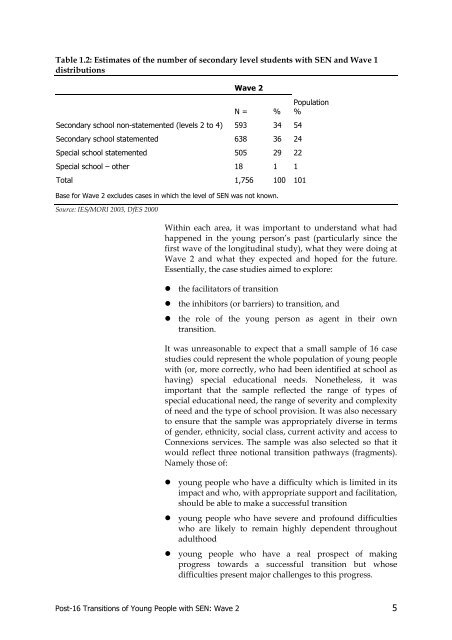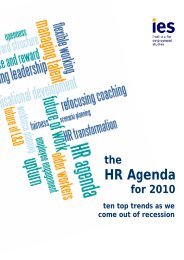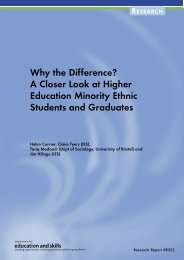Post-16 Transitions: a Longitudinal Study of Young People with ...
Post-16 Transitions: a Longitudinal Study of Young People with ...
Post-16 Transitions: a Longitudinal Study of Young People with ...
You also want an ePaper? Increase the reach of your titles
YUMPU automatically turns print PDFs into web optimized ePapers that Google loves.
Table 1.2: Estimates <strong>of</strong> the number <strong>of</strong> secondary level students <strong>with</strong> SEN and Wave 1<br />
distributions<br />
Wave 2<br />
N = %<br />
Secondary school non-statemented (levels 2 to 4) 593 34 54<br />
Secondary school statemented 638 36 24<br />
Special school statemented 505 29 22<br />
Special school – other 18 1 1<br />
Total 1,756 100 101<br />
Base for Wave 2 excludes cases in which the level <strong>of</strong> SEN was not known.<br />
Source: IES/MORI 2003, DfES 2000<br />
Within each area, it was important to understand what had<br />
happened in the young person’s past (particularly since the<br />
first wave <strong>of</strong> the longitudinal study), what they were doing at<br />
Wave 2 and what they expected and hoped for the future.<br />
Essentially, the case studies aimed to explore:<br />
• the facilitators <strong>of</strong> transition<br />
Population<br />
%<br />
• the inhibitors (or barriers) to transition, and<br />
• the role <strong>of</strong> the young person as agent in their own<br />
transition.<br />
It was unreasonable to expect that a small sample <strong>of</strong> <strong>16</strong> case<br />
studies could represent the whole population <strong>of</strong> young people<br />
<strong>with</strong> (or, more correctly, who had been identified at school as<br />
having) special educational needs. Nonetheless, it was<br />
important that the sample reflected the range <strong>of</strong> types <strong>of</strong><br />
special educational need, the range <strong>of</strong> severity and complexity<br />
<strong>of</strong> need and the type <strong>of</strong> school provision. It was also necessary<br />
to ensure that the sample was appropriately diverse in terms<br />
<strong>of</strong> gender, ethnicity, social class, current activity and access to<br />
Connexions services. The sample was also selected so that it<br />
would reflect three notional transition pathways (fragments).<br />
Namely those <strong>of</strong>:<br />
• young people who have a difficulty which is limited in its<br />
impact and who, <strong>with</strong> appropriate support and facilitation,<br />
should be able to make a successful transition<br />
• young people who have severe and pr<strong>of</strong>ound difficulties<br />
who are likely to remain highly dependent throughout<br />
adulthood<br />
• young people who have a real prospect <strong>of</strong> making<br />
progress towards a successful transition but whose<br />
difficulties present major challenges to this progress.<br />
<strong>Post</strong>-<strong>16</strong> <strong>Transitions</strong> <strong>of</strong> <strong>Young</strong> <strong>People</strong> <strong>with</strong> SEN: Wave 2 5

















